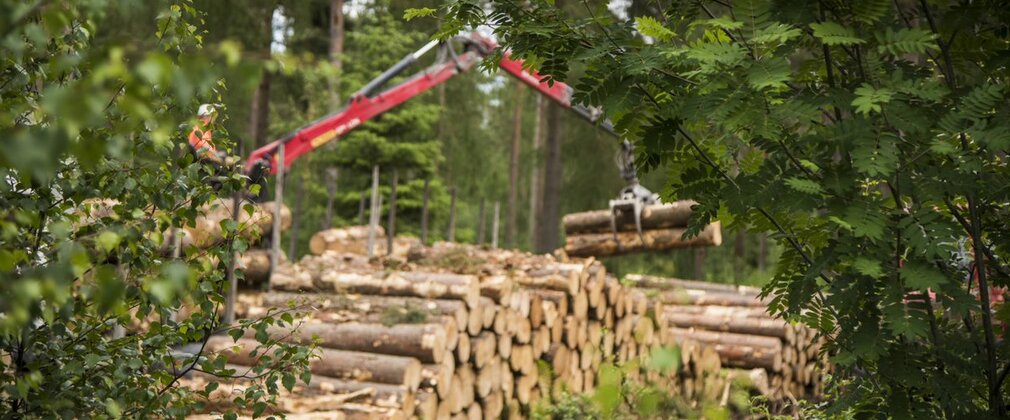Forest operations at Milkwall
Updated August 2024: Track Reinstatement
Brash and branches have now been cleared from the main and most used paths so that they are now accessible.
Sadly we are not able to do this to all of the paths that once existed, over time new paths will be created by people using the woodland.
Updated March 2024: Roadside forestry operations work
We now have confirmed dates with National Grid for the felling work to start to remove the diseased larch in Milkwall Inclosure. We will also remove any roadside ash trees at the same time that are showing signs of Chalara ash dieback.
The work will begin on Monday 11 March 2024 with two-way traffic lights in place on Ellwood Road between the southern end below St James’ Caravan Park and Ellwood, progressing through the site for the following three weeks to coincide with each powerline shutdown date.
There will be temporary traffic disruption on the following dates:
- Tuesday 19 March and Wednesday 20 March: Access from the B4428 into Lambsquay Road to Coleford Garden Centre will be closed. A diversion will be in place along Tufthorn Avenue.
- From 20 March there will be traffic lights on the B4228 (at the Clearwell junction from Coleford) to allow us to safely fell a few trees.
An extension to the Plant Health Notice has been granted so that this felling can be completed outside of the original time period.
The works will impact some of our trails and access points, including Scarr Bandstand car park and Darkhill car park.
This page provides more information about the work we are doing and why.
Brash raking works have started
Visitors to the area may have noticed that activity is underway again in Milkwall Inclosure. We are preparing the area for planting over the next couple of months by brash raking the ground (raking brash into rows with a machine to leave bare ground in which to plant the trees).
We will be replanting this winter 2024 / 2025 after leaving the ground bare for over a year with a mixture of conifer and broadleaved species.
Fencing will begin towards the end of February 2024, beginning with the southern part of the site and continuing in the northern part. Fencing is necessary to provide protection for the planted trees from deer, boar and other wildlife. We will endeavour to maintain access as far as is practically possible.
What is happening?
We are working to remove trees infected with Phytophthora ramorum.
You will notice a significant operational presence in the woodland with banks persons, harvesting machinery, signage and timber stacks. We do our best to use existing extraction routes to minimise the damage to the forest floor, which is inevitable with the scale of machinery that must be used. This will be reinstated where necessary on completion of the work.
Harvesting contracts can sometimes be quite drawn out and work may stop for some time due to the many constraints that we have to work around. So please bear with us as we carry out this work with the aim of minimising inconvenience to all site users.
What is Phytophthora Ramorum?
Phytophthora ramorum is an algae like organism called a water mould. It causes extensive damage and death to more than 150 plant species, including some forest species.
Larch trees, which were widely planted for the timber market, are now known to be particularly susceptible, and large numbers have been affected. It is sometimes referred to as 'Larch Disease'. Phytophthora ramorum does not just affect Larch, it can also affect European sweet chestnut trees and other species.
There is no cure for Phytophthora ramorum disease available at the moment. The best available scientific advice is to remove trees infected with the disease.
Preventing and minimising spread
Phytophthora ramorum spores can be spread over long distances via mists, air currents and watercourses. It can also be spread on footwear, dogs' paws, tools, equipment, and vehicle wheels, including buggies and mountain bike wheels.
Visitors to the forest can help to minimise the spread of tree diseases by brushing soil, mud and leaf debris off your footwear and wheels of bicycles, baby buggies and wheelchairs between each visit.
There are additional biosecurity requirements for people who work in or manage woods and forests, such as foresters, forestry workers, tree surgeons and timber hauliers.
Can I still visit this woodland?
Both Scarr Bandstand car park and Darkhill car park will be closed whilst these works take place.
The most important thing for us is to keep the public, our staff, and contractors safe. We will have safety and operational signage displayed, diversions, closures, and banks persons in position where needed. This is for your safety, whether you can see or hear us working, it is important you read and listen to all instructions very carefully and obey all instruction.
Forestry work is very hazardous. A falling tree can weigh several tonnes and hit the ground at nearly 60mph. If a harvesting machine chainsaw snaps, it can fly through the forest like a bullet.
What about the wildlife?
Well managed forests are able to support more wildlife, and harvesting trees is an important part of a sustainable forest lifecycle. Before we start any forestry work, we carry out ecological surveys to check for species such as birds, mammals, rodents, invertebrates, native plants such as bluebells and fungi. We also consider these against complex factors including tree health, how the ground slopes, soil condition, and likely rainfall when planning work that will support our long-term management plan.
While working, we continue to check for wildlife and will adapt, pause or suspend work if we find any animal that must be protected.
Will you be replanting?
Yes we are, the ground will be prepared for restock by what is known as ‘brash raking’. This is where the brash is raked into rows with a machine to leave bare ground in which to plant the trees. Replanting is planned for the winter 2024/2025.
Diverse forests are more resilient so we are increasing the diversity of tree species we plant so the nation’s forests are better protected from pests, diseases and the effects of a changing climate.
A range of conifers, used for timber, as well as native broadleaf species tolerant to disease have been chosen for this site, species such as Penduncular oak, Japanese red cedar, Douglas fir and Wild Service tree. All of the trees are grown from seed in our own nurseries which have the highest biosecurity restrictions.
Whilst the trees are young, the replant area will need to be fenced to protect them from wildlife such as deer, boar, rabbits and sheep.
Will you reinstate the tracks and paths?
Yes, when the works have been completed any necessary reinstatement of the main paths will take place. Brash will be removed and significant rutting will be flattened out. Some desire lines may remain blocked but over time new paths will be created by people and animals using the woods.
What happens to the timber once its felled?
The felled timber can be used but it must be done by following agreed biosecurity measures. A special movement licence is required before the timber can be transported, and it can only be taken to a sawmill which has a processing licence.
More information on Phytophthora ramorum
Can be found on our webpage: www.forestryengland.uk/west-phytophthora-ramorum
If you would like any further information, please get in touch via westengland@forestryengland.uk

